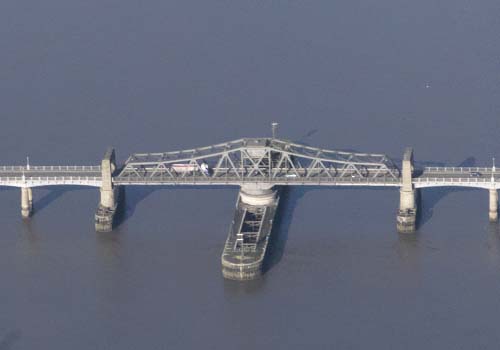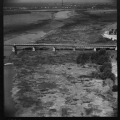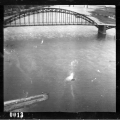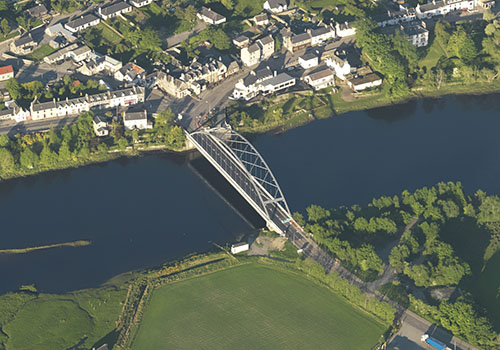Bridges
Bridges carry people and vehicles over natural obstacles such as rivers, gorges and depressions and are vital components in any communications network. They are built in a variety of forms, listed and illustrated in this feature with examples from aerial photography held at NCAP.
Bridge Forms
An arch bridge is held in place by the abutments at either end, which support the weight of the bridge and its load. Arch bridges were common constructions until the invention of new forms during the industrial revolution, when new materials became available.
|
 |
The bascule, or drawbridge, is hinged at one end and a counterweight is used to aid in lifting the deck. This type of bridge is commonly seen along canals and navigable rivers where the deck of a fixed bridge would normally be too low for large boats to pass under.
|
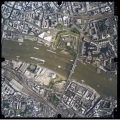 |
A simple design, the beam and deck bridge consists of two or more parallel beams placed over the gap to be spanned, and some form of decking placed on top. The road bridge in the background of this image is a typical example of this type.
|
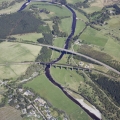 |
Also known as the tied-arch bridge, bowstring bridges can be built on areas of unstable soil since the bottom chord ties the tips of the arch together, like the string of a bow. The arch itself is often formed by a steel truss.
|
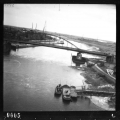 |
The deck of a cable-stayed bridge is supported by individual cables extending from the bridge towers.
|
 |
In its simplest form, a cantilever is a beam extending out over a gap. Two such beams, from either side of the gap, form a pair of cantilevers. |
 |
|
A composite bridge uses more than one type of form to span an obstacle. This example features multiple beam and deck spans and three individual bowstrings followed by further beam and deck spans to carry a road between the Danish islands of Falster and Zealand.
|
 |
A development of the beam and deck bridge, the strength of steel girders allow wider gaps to be bridged than by using materials such as wood or concrete.
|
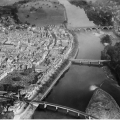 |
The use of diagonally-crossing steel members bolted together results in a steel bridge which is lighter than a girder bridge. In this example, the bridge in the foreground comprises individual lattice spans, each with a curved top chord.
|
 |
In a vertical lift bridge, the deck is kept horizontal and is lifted between two towers. These bridges are often employed along navigable rivers and canals, where the span is lifted to allow boats to pass.
|
 |
|
Using floats or shallow-draft barges to support the deck, pontoon bridges are predominantly employed by the military and, since they block the water channel, are normally temporary in nature. They can be used to supplement an existing bridge or to facilitate crossing where a bridge has been destroyed, as in this example.
|
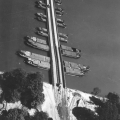 |
|
The portal frame bridge is a modification of the beam and deck type bridge, where the supports are inclined inward. This form of bridge is commonly employed to carry roads over motorways, or for aesthetic reasons
|
 |
Cables suspended from tall towers, and anchored to the abutments, secure the deck of a suspension bridge. Bridges of this type can cross wide gaps in a single span and have a degree of flexibility in poor weather conditions.
|
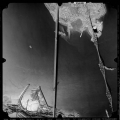 |
Swing bridges horizontally pivot the bridge deck to allow water traffic to pass. The pivot will be positioned within the river channel, either centrally or to one side, and a rest pier may be employed to support the weight of the bridge when open.
|
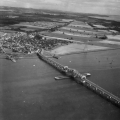 |
|
Featuring a framework of individual members, a truss is a strong, lightweight construction commonly used in through-type railway bridges or as the beam in a beam-and-deck bridge. The deck of the rail bridge in the background of this image is formed by a steel truss.
|
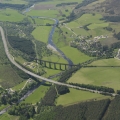 |
Bridge Types
Bridges can be supported by abutments, piers, columns, bents and trestles. When describing a bridge, it is useful to detail the bridge type, its form and its supports, as well as any pedestrian features such as recesses and parapets that may be present. Some typical bridge descriptions appear below.


